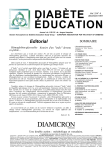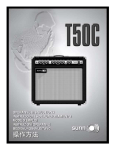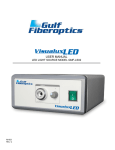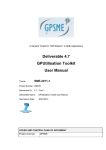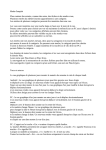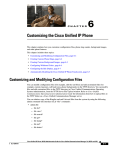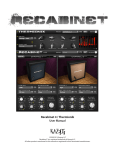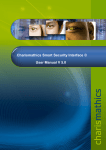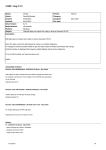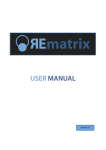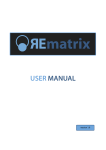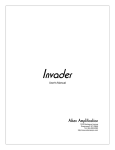Download EPSi User`s Manual in PDF format
Transcript
EPSi Effect Processor User’s Manual l gidy Table of Contents Table of Contents..................................................................................................2 Document revisions ..............................................................................................3 Introduction ...........................................................................................................3 1. Presentation...................................................................................................4 1.1. What is the EPSi? ......................................................................................4 1.2. What is Convolution? .................................................................................4 2. Plugging In.....................................................................................................4 2.1. Power Jack.................................................................................................5 2.2. Audio Inputs ...............................................................................................5 2.3. Audio Outputs ............................................................................................5 2.4. SD Card Slot ..............................................................................................6 3. EPSi User Interface .......................................................................................6 3.1. Firmware Version .......................................................................................6 3.2. Changing Parameter Values ......................................................................6 3.3. Foot Switch ................................................................................................7 4. Parameter List ...............................................................................................8 4.1. Version 1.01 Parameter List.......................................................................8 4.2. Version 1.01 Algorithm...............................................................................8 4.2.1. Quality ....................................................................................................8 4.2.2. Stereo image generator ..........................................................................9 4.2.3. Adding some life to linearity....................................................................9 4.3. Version C.01 Parameter List ....................................................................10 4.4. Version C.01 Algorithm ............................................................................10 4.4.1. Quality ..................................................................................................10 4.4.2. Stereo operation ...................................................................................11 4.4.3. Tone Controls .......................................................................................11 5. Managing Impulse Response Files..............................................................11 5.1. SD Card and File Format .........................................................................11 5.2. EPSi “EPDA” Folder.................................................................................11 5.3. File Naming Convention ...........................................................................12 Appendix A: Specifications .................................................................................13 Appendix B: Error Codes ....................................................................................14 Appendix C: Reverb Impulse Responses List (IR V1.00)....................................15 Appendix D: Cab Impulse Responses List (IR V1.00).........................................17 2 Document revisions Dec 1 2013: Original draft. EPSi firmware 1.00 Jan 10 2014: Added a few details Jan 13 2014: Fixed error “128 samples” Feb 19 2014: Added support for Version C.00 Jun 04 2014: Added support for Version 1.01 and C.01 Introduction Thank you very much for purchasing a Logidy EPSi Effect Processor. We hope you find our product an inspiring tool in your quest toward musical bliss. You will find in this document all the information you might need to get the best out of our product. Lets’ get started. 3 1. Presentation 1.1. What is the EPSi? The Logidy EPSi Effect Processor (EPSi from now on) is a DSP powered effects processor packed in a small pedal format. The interface and the inner workings of the EPSi are not tied to a particular application. Actual parameter names only show on the 3 character LED display and can be changed. And because the firmware running on the pedal is easily replaced via an SD Card, the EPSi can be turned into many different things. As of now there are two versions of firmware available for the EPSi: - Version 1.xx: This version is optimized for reverb sounds. Version C.xx: This version is optimized for cabinet speaker and room sounds. Both versions make use of convolution and the SD Card to load sounds. 1.2. What is Convolution? The behavior of a linear time invariant system (like an acoustic hall or a linear EQ) is fully described by its impulse response. An impulse response can be obtained by recording the sound coming out of such a system when an impulse – a kind of short pop – is applied to it. Once this impulse response is acquired, the behavior of that system can be recreated by convolving that impulse response with an input signal in a process that is equivalent to filtering. To simulate acoustic reverberation sounds the time window of that filter is as long as the decay of the effect. This leads to high computational requirements for long decay times. In the reverb version of the firmware we are able to reach windows of about 6 seconds in duration, which is long enough to simulate an acceptable variety of sounds found in nature or in devices trying to mimic it. Version C of the firmware is optimized for zero latency convolution and dual channel processing. This leads to a reduce time window of 1.5 second. 2. Plugging In If you have used effect pedals in the past, you will find that incorporating the EPSi works pretty much the same way as with any other pedal. The EPSi features 4 audio connectors on the back - 2 stereo pairs, one for importing 4 analog audio into the pedal and one producing analog audio out, as well as a power jack. The connectors are laid out as shown here: L(M) OUT 2.1. R 9V DC L(M) IN R Power Jack Connect the included 9 Volt power supply to an AC outlet and to the power jack at the back of the unit. The EPSi uses the most common voltage polarity for effects pedals with the positive potential on the outside sleeve of the connector. Caution: When using a different power supply, make sure it conforms to the specifications given at the end of this document. Insufficient or excessive current/voltage can easily result in damaging the electronic circuits inside the pedal and render it inoperable. As soon as the EPSi is powered, it will start right away and go through its startup sequence. See the user interface section for more on this. 2.2. Audio Inputs Facing the back of the unit, the input connectors are on the right. The EPSi can take in either a mono or a stereo signal. If a single jack is plugged in the L(M) input – which stands for “Left(Mono)” – the signal coming from that input will be copied onto the right side channel creating an internal split. If a single jack is plugged in the R input – which stands for “Right” – no direct signal will go to the left side channel. The impedance of the input stage is set so that an electric guitar can be plugged in directly without suffering much loss in brightness in the sound. EPSi features an analog direct path so as not to add any latency to the dry signal. This dry path can be disabled through the user interface. 2.3. Audio Outputs 5 Facing the back of the unit, the output connectors are on the left. Plugging a single jack into the L(M) connector – which stands for “Left(Mono)” – has no effect on the dry path, but causes the left and the right channels of the processed audio to be summed. 2.4. SD Card Slot The EPSi uses impulse responses stored on an SD Card. The unit arrived to you with an SD Card pre-loaded with a collection of impulse responses. If, on powerup the EPSi does not detect the presence of a card, a test impulse response generated internally is used instead. Cards can be inserted and removed while the unit is running. Each time a card is inserted, the system will inspect its contents and adapt accordingly without interrupting the audio processing. SDHC Cards are currently not supported. 3. EPSi User Interface The EPSi features a simple user interface including an endless value rotary control, a button for stepping through parameters, a foot switch and a 3 digit LED character display. Note: Because the front panel of the EPSi does not explicitly name parameters, it is possible for us to add/remove/change parameters in software. Make sure that the version of this document matches the version of the firmware that is running on your EPSi. 3.1. Firmware Version On power up the EPSi first displays the version number of the firmware being currently run. If an SD Card is present the system will quickly proceed with the file initialization and take over the display. If a card is not present, the firmware version number will show until the user interface is interacted with. The Firmware on the EPSi can be replaced via the SDCard. Exact details on how to perform a firmware update are provided on our website along with the new program file. 3.2. Changing Parameter Values Parameters on the EPSi are changed one at a time by stepping through them with the “Param” button and using the “Value” knob. 6 A single push on the “Param” button causes the display to reveal the name of the current parameter. That name shows as long as the button is pushed and for about 2 seconds after the button is released. After that the display reverts to showing the value for that parameter. If the button is pushed again within the 2 seconds, the next parameter in the list becomes current and its value can be changed with the “Value” knob. When the last parameter is reached, the stepping loops back to the first parameter. Scrolling through parameters can also be done while holding the “Param” button down and turning the knob. The parameter list can be scrolled through up or down that way. Exception: Recalling an Impulse Response In the case of the first parameter the “param” button is also used to trigger the loading (“Recalling”) of a new impulse response. When the value shown for the first parameter does not match the index of the currently loaded impulse response, the display will alternate between the value and “rcL” as shown here: “rcL” stands for “recall” and will flash 4 times for about 5 seconds. If the “param (Recall)” button is pushed during that time, the system will interrupt audio processing and load the new impulse response. If the button is not pushed during that time, the display reverts to showing the current impulse response index number and stepping though parameters can resume. 3.3. Foot Switch The foot switch on the top panel act as an effect enabling/disabling control. When the effect is bypassed the display shows the following symbol: Disabling the effect is equivalent to disabling the input of the effect. This means that its trail will still be heard for some time after the foot switch is pressed. While the effect is disabled access to parameters is still possible. When the user interface is accessed the display reacts accordingly, but the display eventually reverts to showing the symbol shown above. 7 4. Parameter List 4.1. Version 1.01 Parameter List Display Meaning Values 1.Sd The Index of the SD The values available depend on the contents of the SD Card (see file naming section) Card File used as an impulse response 2.FL FX Level. The level of the Unit: dB. processed audio AKA “wet” level. Range: -40dB to +10dB Actual resolution: 0.25dB steps 3.rt Reverb Time. The decay Unit: seconds Range: from 50% to 150% of the nominal time of the impulse response* time in seconds for the impulse response. This is the measured RT60 4.dr Dry Path Enable. The state of the internal analog direct path relay. Unit: none Range: on - off Unit: Hz frequency. The wet path has an Range: Off, 18 - 992 adjustable high pass filter. 5.HP High pass filter cutoff * Increasing or decreasing the perceived decay is done by applying a volume envelope to the impulse response. When increasing the decay time, the envelope adds gain to the end of the tail also increasing whatever noise might be in the file. This can sometimes make the tail sound unnatural. 4.2. Version 1.01 Algorithm 4.2.1. Quality Convolution is a straightforward process. Although there are several ways this process can be optimized for computational bandwidth, the end result can not differ form the simple theory. At the root and with a large enough bit depth (32-bit 8 floating point in our case) all convolvers sound the same. The quality of the sound generated largely depends on the quality of the impulse response used. A peaky or fluttery impulse response form a low quality algorithmic reverb unit will sound the same on the EPSi. However an impulse response from a very diffused and uneven acoustic space will sound as smooth and transparent on the EPSi. The collection loaded on the SD Card included with the EPSi has impulses from many different high quality sources (acoustic, electronic, electromechanical, and synthesized). The maximum Impulse response duration is about 6 seconds (262144 samples at 44.1 KHz). Only the first 6 seconds of data get loaded for longer duration files. This can result in a very abrupt sounding cutoff if the wave does not include some sort of fade out within that time span. The processing latency of the wet path is about 10.0 ms. As pre-delays in reverb sounds are often longer than this, the latency is not noticeable on reverb sounds. For zero latency processing, see firmware version C. 4.2.2. Stereo image generator In order to reach our 6 second time window the DSP can only process one channel. The EPSi only uses the first channel of a multichannel wave file. EPSi uses an original adaptive algorithm to synthesize a new stereo image. The result of this process sounds as if the impulse was re-captured with an M/S microphone pair and is convincing for most space simulation applications. However any hard panning built in the original impulse is lost through this process. The stereo image generator is disabled when the right output jack is left unplugged (mono output mode). In this situation the processed signal is an exact rendering of the convolution. 4.2.3. Adding some life to linearity Basic convolution is a perfectly linear process. It can not simulate any sort of distortion or time varying effect. This can result in the output sounding somewhat stale. To remedy this, the stereo image generator also includes a little bit of detuning. The detuning amount is very slight (1.5 cent). The result is some subtle added sense of motion and chorusing, widening and warming up the sound with no audible pitch shifting. 9 4.3. Version C.01 Parameter List Meaning Values 1.Sd The Index of the SD Card File used as an impulse response The values available depend on the contents of the SD Card (see file naming section) 2.Lo Low frequency tone Unit: none. Range: 0.0 to 10.0 control level 3.Md Mid frequency tone control level 4.Hi High frequency tone control level 5.LF Low frequency tone control cutoff 6.HF High frequency tone control cutoff 4.4. Unit: none Range: 0.0 to 10.0 Unit: none Range: 0.0 to 10.0 Unit: KHz Range: 0.01 to 9.90 Unit: KHz Range: 0.01 to 9.90 Version C.01 Algorithm 4.4.1. Quality The algorithm in Version C is optimized for zero latency processing. The actual latency measured from analog input to analog output is 1.04 ms, 80% of this is due to the group delay of the anti aliasing filters of the A/D and D/A converters. A maximum convolution window in stereo of 1.5 sec (65536 samples) can be achieved. 10 4.4.2. Stereo operation Version C always processes audio on the left and the right channels independently. It can use either stereo or mono WAV files. If a mono file is used the same impulse is loaded on both channels. Unlike version 1, version C does not alter the stereo imaging in any way. 4.4.3. Tone Controls Version C features an extra filter emulating the general behavior of the tone stack of a guitar amp. The Low and High controls are used to increase the level in their respective frequency bands, while the Mid control is used to set the general level of the filter, the same way some classic tube amps handle EQ’ing. The cutoff frequency for the High and Low bands can also be adjusted. This allows “voicing” of the EQ to various tone stack colors. To flatten the EQ the following settings should be used: - Low: 0.0 Mid: Any value. In this setting the Mid becomes a general level control. High: 0.0 5. Managing Impulse Response Files 5.1. SD Card and File Format The EPSi handles SD Cards formatted with either FAT16 or FAT32 file systems. Inserting a card with a different format will trigger an error message. SDHC Cards are currently not supported. Impulse response files are 44.1 KHz Wave Files with either 16 or 24 bit depth. Trying to load files that do not match this specification will trigger an error message. 5.2. EPSi “EPDA” Folder The Epsi looks for files in a specific folder on the root directory of the SD Card called “EPDA”. If that folder does not exist, the EPSi reports an error. All files to 11 be used by the EPSi should be included in that folder. The EPSi ignores all subfolders in “EPDA”. 5.3. File Naming Convention The EPSi differentiates impulse response files by looking for a 3 digit indexing prefix in the file name. When an SD Card is inserted, the EPSi searches for all files having that prefix and the .WAV extension and then creates a sorted list that can be scrolled through as the first parameter (1.Sd). The EPSi only looks for 3 digits at the beginning of the file name. The rest of the file name is ignored. Note: If two Wave files have the same 3 digit prefix, the EPSi lists only one of them - picking the one somewhat randomly. On a computer a file name might look like this: 123 impulse response name.wav The EPSi shows the file as: Note: The indexing prefixes in a list of files do not need to be contiguous. The EPSi only displays any combination of the 1000 available (000 to 999) that actually exists in the EPDA folder. 12 Appendix A: Specifications Analog: Nominal audio input/output level: Clipping audio input/output level: Dynamic range: Frequency response (+/- 1dB): Bypass type: Input Impedance: -10 dBm +2 dBm 100 dB 20Hz – 20KHz Buffered analog 500 KOhm Digital: Sampling Rate: Processing Bit Depth: 44.1 KHz 32 Bit Floating Point Inputs – Outputs: Audio inputs: Audio outputs: Data connector: Power connector: 2 * 6.35 mm (0.25 “) phone jacks 2 * 6.35 mm (0.25 “) phone jacks 1 SD Card socket 2.1 * 5.5 mm Mechanical: Size: Weight: 10.1 * 11.3 * 5.9 cm 4.0 * 4.5 * 2.3” 400g 15 oz Power: Supply Voltage: Supply Current: 9V – 12V DC (center negative) 250 mA 13 Appendix B: Error Codes Display Meaning Resolution Error 0: Hardware self test error Contact customer support Error 1: SD Card initialization error Try another SD Card Error 2: File System error - Verify SD Card format - Format SD Card as FAT16 or FAT32. No SDHC. - Check wave attributes - Resample to 44.1KHz - Change bit depth to 16 or 24 Try replacing the application firmware via the SD Card. Error 3: Wave file loading error Error 4: Firmware loading error (boot loader generated) 14 Appendix C: Reverb Impulse Responses List (IR V1.00) 1xx: Rooms 100 Busy Slap.wav 101 White Closet.wav 102 Tiny Closet.wav 103 The Box.wav 104 Small Room.wav 105 Boiler Room.wav 106 Science Room.wav 107 Hotel Room.wav 108 Vintage Reflections.wav 109 Small Tiled Room.wav 110 Bright Room.wav 111 Circular Room.wav 112 Room Algo.wav 113 Small Cave.wav 114 Large Room.wav 115 Small Club.wav 116 Slap Cafe.wav 117 Studio.wav 118 Empty Room.wav 119 Back Room.wav 120 Computer Room.wav 121 Real Room.wav 122 Sun Room.wav 123 Mens Room.wav 124 Live Room.wav 125 Classroom.wav 126 Large Dark Room.wav 210 Warm Hall.wav 211 Vocal Hall.wav 212 Sparkle Hall.wav 213 Digital Concert.wav 214 Medium Hall.wav 215 Deep Hall.wav 216 Leaky Hall.wav 217 Concert Hall.wav 218 Long Hall.wav 219 Dark Hall.wav 220 Large Hall.wav 221 Vintage Hall.wav 222 Long Wash.wav 223 Large Hall.wav 2xx: Halls 200 Tiny.wav 201 Small Hall.wav 202 Drum Hall.wav 203 Recital Hall.wav 204 Small Dark Hall.wav 205 Spike Hall.wav 206 Studio Hall.wav 207 Dense Hall.wav 208 Bright Hall.wav 209 Stage Hall.wav 3xx: Spaces 300 Small Cave.wav 301 Camp Site.wav 302 Forest.wav 303 Canyon.wav 304 Small Church.wav 305 Speaker Hall.wav 306 Parking Garage.wav 307 Factory.wav 308 Large Church.wav 309 Glass Church.wav 310 Gymnasium.wav 311 Arena.wav 312 Dark Church.wav 313 Warehouse.wav 314 Very Large Church.wav 315 Cathedral.wav 4xx: Plates 400 Old Plate.wav 401 Tiny Plate.wav 402 Ambient Plate.wav 403 Shiny Plate.wav 404 Dense Plate.wav 405 Rich Plate.wav 406 Horn Plate.wav 407 Deluxe Plate.wav 410 EMT Dark.wav 15 408 EMT Bright.wav 409 Factory Plate.wav 5xx: Springs 500 Short Spring.wav 501 Bright Spring.wav 502 Tape Spring.wav 503 Cheap Spring.wav 504 Dark Spring.wav 505 Multi Spring.wav 506 Fake Spring.wav 507 Medium Spring.wav 508 Tube Spring.wav 509 Deep Spring.wav 510 Combo Spring.wav 511 Dub Spring.wav 6xx: FX 600 gated slap.wav 601 Machine Echo.wav 602 Squeeze.wav 603 Drum Roll.wav 604 FX Snare.wav 605 Slurp.wav 606 Alien.wav 607 Automatic.wav 608 Water.wav 609 Chirp1.wav 610 Chirp2.wav 611 Drum Fill.wav 612 Saw Mod.wav 613 Splash Cymbal.wav 614 Shaker Loop.wav 615 Drum Loop.wav 616 Krypto Froth.wav 617 Radio Jamming.wav 618 Cymbal.wav 619 Encounter.wav 16 620 Bloom.wav 621 Applause.wav 622 Long Sweep.wav 623 In Session.wav Appendix D: Cab Impulse Responses List (IR V1.00) 1xx: Single or dual speaker cabs 100 1X12 Celestion Blue.wav 101 1X12 Jensen P12R.wav 102 1X15 Jensen C15.wav 103 2X12 Alnico Blue.wav 104 2X12 Alnico Silver.wav 105 2X12 Jensen C12N.wav 106 2X12 JBL D120.wav 107 2X12 Roland JC120.wav 108 2X12 Celestion G12M25.wav 109 2X12 Celestion G12H30.wav 110 2X15 JBL D130.wav 2xx: Quad speaker cabs 200 4X12 Sheffiled 1200.wav 201 4X12 Celestion G12L.wav 202 4X12 Celestion G12H30.wav 203 4X12 Celestion G12M20.wav 204 4X12 Celestion G12M25.wav 205 4X12 Celestion G12M.wav 206 4X12 Celestion G12T75.wav 207 4X12 Celestion G12T75.wav 208 4X12 Celestion V30.wav 209 4X12 Celestion V30.wav 210 4X12 Celestion V30.wav 211 4X12 Celestion V30.wav 212 4X12 Celestion V30.wav 213 4X12 Eminence S12X.wav 214 4X12 Eminence Legend V12.wav 215 4X12 Fane 122231.wav 216 4X12 JBL K120.wav 217 4X10 Jensen P10Q.wav 3xx: Single or dual speaker cabs with added studio ambiance – Same list as 1xx 4xx: Quad speaker cabs with added studio ambiance – Same list as 2xx 17


















